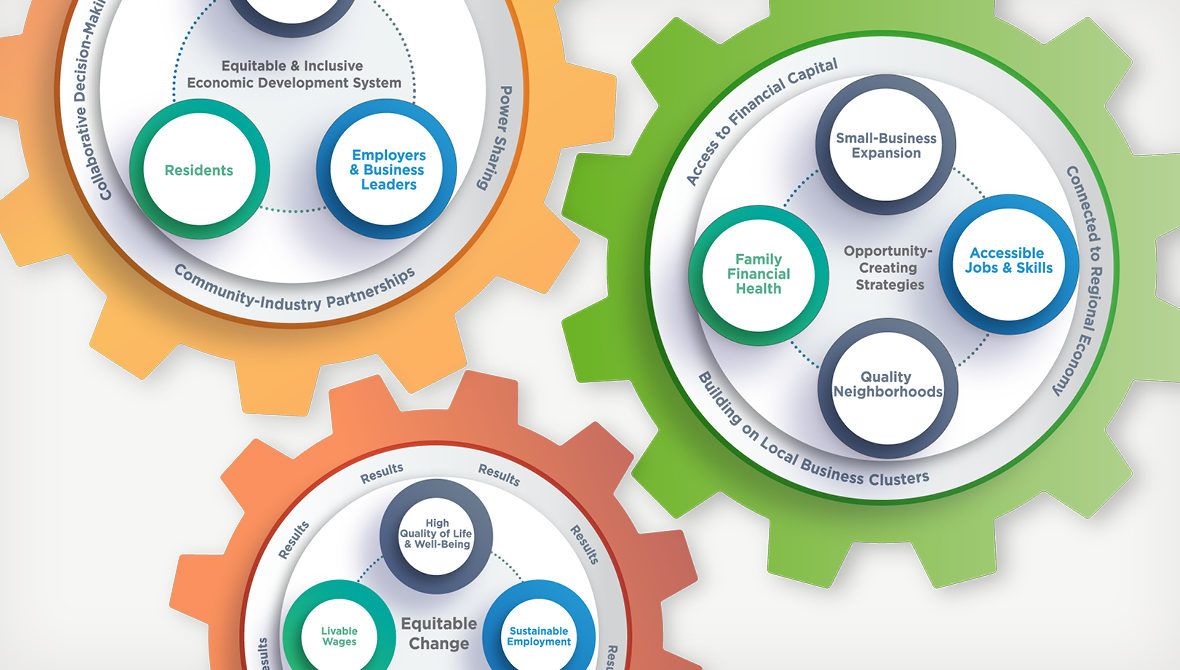Inclusive Growth Communities: Tools, Practices, Collaborations, and Commitments


 This issue of The Foundation Review is focused on how foundations and nonprofit organizations support efforts to create “inclusive growth” communities. Inclusive growth is defined as more people sharing in the rewards of a growing economy and community. In this context it is considered a process and an outcome. These are communities that invest through philanthropy, public policy, private and public financial decisions, and community commitments. The process involves collaborations across the public, private, and nonprofit sectors in tackling the complexity of creating upward mobility for everyone, especially marginalized communities. These entities contribute to inclusive growth by addressing health inequities, access to quality education, affordable housing, and community and economic development. Philanthropy also contributes through roles such as leader, convener, influencer, and advocate.
This issue of The Foundation Review is focused on how foundations and nonprofit organizations support efforts to create “inclusive growth” communities. Inclusive growth is defined as more people sharing in the rewards of a growing economy and community. In this context it is considered a process and an outcome. These are communities that invest through philanthropy, public policy, private and public financial decisions, and community commitments. The process involves collaborations across the public, private, and nonprofit sectors in tackling the complexity of creating upward mobility for everyone, especially marginalized communities. These entities contribute to inclusive growth by addressing health inequities, access to quality education, affordable housing, and community and economic development. Philanthropy also contributes through roles such as leader, convener, influencer, and advocate.
Strategies to achieve inclusive growth involve many facets, including examining organizational processes, establishing robust measurement tools, applying systems thinking, utilizing reflective practices, creating cross-sector collaborations, and investing in long-term commitments.
Inclusive growth communities will only develop and flourish if we are intentional about addressing disparities within our communities. We hope you will learn from these articles as we all strive to create different results from current reality.
In this article, Davids and Meijs explore inclusion and exclusion within civil society by distinguishing two broad approaches: the managerial, based on the private sphere, and the democratic, based upon the public sphere. They share results of a quantitative comparison of the patterns of funding awarded by a regional endowed foundation in the Netherlands to immigrant grassroots associations and to other grassroots organizations. The results reveal differences in funding despite the foundation’s inclusive strategy. They offer a perspective on the importance of understanding the value of immigrant grassroots organizations and how funding decisions are influenced by the funding strategies they take.
Two critical elements of inclusive growth strategies are access and opportunity, especially for low-income people and communities of color. Minzner offers a framework of leading equitable economic development strategies, and proposes an approach for measuring their effects on barriers, opportunities, and end outcomes by population characteristics. She points out the importance of understanding the link between equitable economic development activities and equitable economic impacts. A new measurement strategy is offered to unmask variations of growth for different populations.
The stark reality of wealth disparities and racism in America was illuminated during the COVID-19 pandemic and the public murder of George Floyd and other people of color. Stroh points out that wealth inequality in turn fans structural racism. This article specifically applies systems thinking to identify the root causes of wealth inequality, including structural racism, and then proposes strategies for both fairly distributing and generating new wealth.
Nonprofit infrastructure organizations have been important supports during the COVID-19 crisis as well as addressing disparities during this time. These organizations, according to Prentice, Brudney, Clerkin, and Brien, are divided into three categories: those that support the nonprofit sector as a whole, those that assist nonprofit organizations and their staffs, and those that devote their resources to the communities or region they serve. This article presents a case study of one region in which all three types of organizations were asked to share their responses to nonprofits that sought help in dealing with the coronavirus pandemic. This article offers useful lessons for foundations by demonstrating how nonprofit infrastructure organizations have adapted to COVID-19 to support the nonprofits they serve. It also suggests that foundations should consider funding organizations rather than programs, allowing these nonprofits to address immediate needs.
In this article, Simon, Lloyd, and Francis address the construct of cross-sector coalitions when attempting to impact income inequality and stimulate inclusive growth. These sectors included business, community, and civic leaders. Through these partners the Essex County Community Foundation launched a systems philanthropy strategy to address income inequality and stimulate inclusive growth. The strategy involves a multipronged approach aimed at amplifying the county’s strengths, launching inclusive-growth initiatives, expanding workforce training and skill development, incentivizing and supporting small-business resiliency and growth, and revitalizing and reinventing struggling local industries. This article shares insights into systems philanthropy, the roles played by the foundation and its business and community partners, and how funders can reduce income inequality by investing systemically in inclusive growth.
In attempting to create inclusive growth in communities, it is important to understand that initiatives must be viewed as long term commitments and investments. To understand the implications of these long-term efforts, Brown, David, and Sharma studied The California Endowment’s Building Healthy Communities, a $1.75 billion 10-year initiative to promote health equity. This article aims to build upon the lessons from past place-based work and provide new knowledge from this initiative. The results illustrate the significant role foundations play in determining the outcomes particularly for foundations that take on roles that position them as part of the action rather than merely as sources of funds. The article concludes with reflections about what it takes for a private foundation to succeed in such a complex and long-term endeavor.
Not yet a subscriber? Click here to start your free 90-day trial.